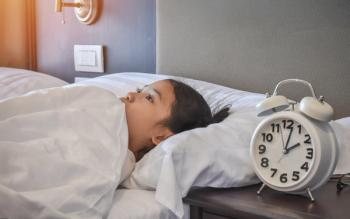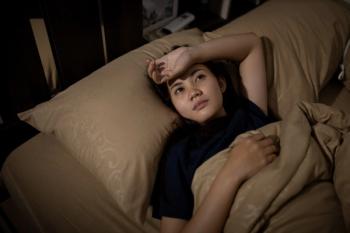Primary Insomnia: A Lifelong Problem
When provided with an array of treatment options, patients tend to feel a sense of ownership by playing a role in their care.
CHALLENGING CASE
Primary insomnia is a decreased ability to fall asleep and/or stay asleep, with resulting daytime effects of sleep deprivation, such as fatigue, dozing off, and irritability. The sleep problems of primary insomnia are not associated with lifestyle habits or a medical or psychiatric cause. Primary insomnia is diagnosed using DSM-5 and the International Classification of Sleep Disorders, 3rd Edition (ICSD-III) classification
This type of insomnia is usually idiopathic, although it can be impacted by mild to moderate stress. Primary idiopathic insomnia occurs without any identifiable cause and in the absence of anxiety. And people who have a history of primary insomnia may also have episodes of sleep state misperception (SSM), also known as paradoxical insomnia. With paradoxical insomnia, a person feels that they are experiencing insomnia, although they are getting enough sleep and don’t experience daytime signs of sleep deprivation. SSM is believed to affect 9% to 50% of the adult population, and it is
Primary insomnia has 3 subtypes: idiopathic, stress-related, and SSM. Idiopathic insomnia is truly without any identifiable contributory factor, while stress-related insomnia can be characterized by mild stress, such as rumination or other thoughts throughout the night. Someone who has had episodes of idiopathic insomniacan also experience worsening symptoms when dealing with mild stress or can experience SSM during phases of adequate sleep.
The frequency of sleep symptoms can vary—primary insomnia can occur occasionally or frequently, and it can affect someone for just 1 night at a time or for many nights in a row. An individual affected by the condition can have trouble sleeping, may toss and turn in bed, or may get up from bed at night. Symptoms can also include 1 or more episodes of waking up during the night, often for less than an hour in total. People who have primary insomnia may be very concerned about the causes and effects of not getting enough sleep, and anxiety about sleep can exacerbate the insomnia.
A diagnostic work-up of insomnia includes a medical history, physical examination, and diagnostic tests. Daytime symptoms can include restlessness, feeling tired, falling asleep easily during waking hours, trouble concentrating, moodiness, and sadness. These symptoms are not usually present in SSM. A sleep study may show delayed sleep latency, sleep fragmentation, decreased sleep efficiency, and
Treatments for primary insomnia include lifestyle modification, therapy, and prescription medications. Non-medical therapies include counseling, cognitive behavioral therapy, biofeedback, avoiding naps or inconsistencies in sleep schedule, managing caffeine and alcohol intake, and avoiding stimulation from factors like bright lights before sleep.3 Medications commonly used for the treatment of primary insomnia
Case Vignette
A 42-year-old woman complains that she isn’t sleeping well at night. Although she is in good health, she reports that she has had trouble falling asleep for as long as she can remember. She recalls being tired in the mornings when she was a child, during her teenage years, and throughout her adult years. This is not related to stress, as she says she had always been even tempered and ambitious, and she isn’t prone to anxiety.
Her current sleep pattern is that she tosses and turns for hours before falling asleep, sometimes wakes up during the night around 4 AM, and generally falls back asleep until her alarm clock wakes her at 6:30 AM. At home, sounds of rain or cars outside wake her from sleep. And when she stays in a hotel, the sound of other people talking or shutting doors wakes her up.
She is a chemist and works full time as a vice president at a manufacturing company. She has a regular 8 to 5 schedule, working from home several days per week for the past several years. This practice is consistent with her company culture because most of the work involves communicating electronically. She says that sometimes she gets very tired during the day, but she works through the fatigue because she does not want to prolong her workday.
She then prepares dinner for her children and husband. After dinner, she usually takes a walk or exercises and later watches television with her family. She has a daughter who is attending college abroad for the year, and two kids in high school. The family often calls their college student daughter in the evening. The patient generally goes to bed around 11 PM after picking up around the house. Overall, although she is busy, she says she doesn’t have anything especially stressful going on in her life.
The patient is having an evaluation of insomnia at the urging of her daughter, who is studying pre-health classes in college. The main concern that she expresses is whether her insomnia could be caused by a health problem or whether she could be at risk of developing chronic health issues due to lack of sleep.
Evaluation and management
The patient’s physical examination was normal. She had a complete blood count and electrolyte blood levels that were normal. She had a home sleep study, which showed diminished sleep quality and delayed sleep latency, without evidence of issues like sleep apnea. She was presumptively diagnosed with primary insomnia, which was considered to be idiopathic.
She was offered the option of taking medication for her insomnia. She instead asked about whether there are any natural therapies, such as herbs, that she could take. In fact, there have been studies suggesting that herbal treatment may have an effect on insomnia. In one
Her doctor suggested that she begin with lifestyle strategies that include avoiding looking at electronic devices for several hours before sleep, avoiding caffeine after noon, and adopting a more consistent exercise schedule. After a month, she did not experience improvement of her symptoms and asked to try prescription medication. Her doctor gave her a prescription for temazepam. After 1 month, she was pleased with the results, but she was concerned about the potential for addiction, so she asked if she could switch to melatonin. Her doctor gave her a schedule to taper the prescription and wanted to reevaluate the situation before starting the patient on another medication. After she discontinued the medication, the patient felt she was still getting better quality sleep and felt less tired during the day. The decision was made to hold off on any new medications as long as her symptoms were not troublesome.
Take home points
• Patients who have primary insomnia might be concerned about medical causes of insomnia. Often, ruling out underlying causes can be a great relief for patients.
• Herbal treatments and alternative therapies may be beneficial in the management of primary insomnia, but doses and adverse effects are not well established.
• Treatment of chronic insomnia can be more effective when the patient is given several treatment options and has a voice in the plan.
• Sometimes temporary treatment can be effective for a bout of chronic primary insomnia that’s idiopathic.
Dr Moawad is Adjunct Professor at John Carroll University, and Instructor, Case Western Reserve University in Cleveland, OH. She is the editor in chief emeritus of Neurology Times (2017-2019).
References
1. Momin RR, Ketvertis K. Primary Insomnia. StatPearls [Internet]. Treasure Island (FL): StatPearls Publishing; 2020.
2. Martucci M, Conte M, Ostan R. Both objective and paradoxical insomnia elicit a stress response involving mitokine production. Aging (Albany NY). 2020;12(11):10497-10505.
3. Melo DLM, Carvalho LBC, Prado LBF, Prado GF. Biofeedback Therapies for Chronic Insomnia: A Systematic Review. Appl Psychophysiol Biofeedback. 2019;44(4):259-269.
4. Taherzadeh Z, Khaluyan H, IranshahyM. Evaluation of sedative effects of an intranasal dosage form containing saffron, lettuce seeds and sweet violet in primary chronic insomnia: A randomized, double-dummy, double-blind placebo controlled clinical trial. J Ethnopharmacol. 2020;262:113116 Epub ahead of print.
5. Akram M, Daniyal M, Munir N, et al. Medicinal Plants Combating Against Insomnia: A Green Anti-Insomnia Approach. J Nerv Ment Dis. 2019;207(11):927-935.
Newsletter
Receive trusted psychiatric news, expert analysis, and clinical insights — subscribe today to support your practice and your patients.















